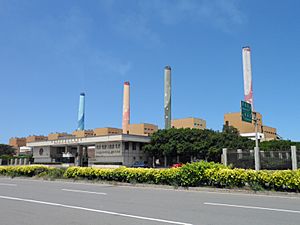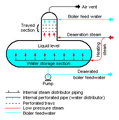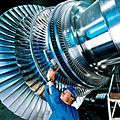Thermal power plant facts for kids

Taichung Thermal Power Plant in Taiwan
A thermal power plant is a power plant where steam is used to drive a steam turbine. This turbine is connected to an electrical generator. After this, the water is condensed, and may be used again. This is known as the Rankine cycle. There are different procedures that can be used to heat the water;
Contents
Components of a thermal power plant
- Cooling tower
- Cooling water pump
- transmission line (3-phase)
- Step-up transformer (3-phase)
- Electrical generator (3-phase)
- Low pressure steam turbine
- Condensate pump
- Surface condenser
- Intermediate pressure steam turbine
- Steam Control valve
- High pressure steam turbine
- Deaerator
- Feedwater heater
- Boiler steam drum
- Superheater
- Forced draught (draft) fan
- Reheater
- Combustion air intake
- Induced draught (draft) fan
Main disadvantage of fossil fuel thermal power plant
Fossil fueled thermal power plants produce a large part of man-made CO2 emissions to the atmosphere, and efforts to reduce these are varied and widespread.
- It occupies lot of space and release gases.
Related pages
- Geothermic power plant
- thermal energy from the oceans
- solar power
- nuclear power plant
- coal and other fossil fuels, such as gas
Images for kids
-
Grafenrheinfeld Nuclear Power Plant in Bavaria
-
A Rankine cycle with a two-stage steam turbine and a single feed water heater.
See also
 In Spanish: Central termoeléctrica para niños
In Spanish: Central termoeléctrica para niños

All content from Kiddle encyclopedia articles (including the article images and facts) can be freely used under Attribution-ShareAlike license, unless stated otherwise. Cite this article:
Thermal power plant Facts for Kids. Kiddle Encyclopedia.








